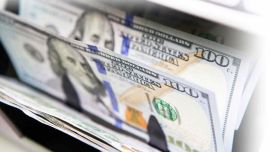Argentina’s decision to extend its defence of the peso to the parallel market is draining its foreign currency reserves and denting the most fragile of commodities in its battered economy: investor confidence.
On July 13, the government announced for the first time that it would intervene in the so-called 'blue chip swap' rate to prop up the peso, expanding its efforts from the official market where it allows the peso to weaken just two percent a month against the dollar. Since then, the peso has risen roughly nine percent against the greenback in the parallel market.
The move is a sign of increasing frustration over inflation, which is currently running at 272 percent. A weaker peso increases the cost of imports and stokes price increases.
But the intervention comes at a heavy cost. Central Bank reserves have tumbled as much as US$1.9 billion since the announcement. That is money the authorities can ill afford to lose, with payments on international bonds set to leap to US$9.4 billion next year, half of which are in January. The brokerage Portfolio Personal Inversiones, or PPI, estimates net reserves stood at a negative US$6.7 billion as of July 30.
These moves “are old recipes for new problems and they don’t work,” said Joaquín Almeyra, a fixed-income trader at Bulltick LLC in Miami. “Any type of intervention generates distrust.”
The government told brokers this week that the recent drop in reserves was due to debt payments and energy imports, and that its savings would start to rise again in the fourth quarter, according to people who declined to be named as the talks weren’t public.
A spokesperson for the Economy Ministry didn’t immediately respond to a request for comment.
Argentina’s parallel blue-chip rate, also known as the 'contado con liquidacion' rate, is derived from buying securities in one currency and then selling them in the other.
The Central Bank has intervened in the market by buying sovereign notes in dollars and then selling them in pesos, draining the supply of local currency and pushing up its value.
The blue-chip rate currently stands at around 1,288 pesos to the dollar, compared with 1,405 before the intervention. Still, the peso hasn’t strengthened as much on the black market, known as the dollar blue.
The intervention in the parallel market, PPI said, cost the government US$231 million to US$261 million between July 15 and July 26, which is when the brokerage estimates officials last meddled.
The subsequent decline in reserves is fuelling concern over debt repayments that have mounted amid a steep recession, persistently high inflation and the weaker currency. Argentina’s sovereign bonds have underperformed since, returning a negative 1.3 percent following the announcement through July 30, according to a Bloomberg index.
While Argentina exhibits a “high willingness to pay of its debt,” UBS strategists Alejo Czerwonko and Pedro Quintanilla-Dieck wrote on July 24, “the key question now remains whether the country will have the capacity to pay.”
The currency intervention contravenes International Monetary Fund recommendations, dimming prospects for fresh funding, Fitch Ratings analysts Todd Martínez, Shelly Shetty and Mark Brown wrote around the same date.
Argentina has a US$44-billion loan programme with the IMF and is likely to need a new deal before repayments increase in 2026.
Not only is intervention expensive, it may also prove futile in the long-term, with the peso already viewed as overvalued and many analysts expecting a devaluation in the official market.
President Javier Milei’s administration has ruled out accelerating the two-percent monthly pace at which they let the peso slide, as well as another abrupt one-off devaluation, as they did in December. If anything, Milei has said he intends to slow the pace of the decline to one percent a month once core or wholesale inflation reaches two percent. The wholesale printed was 2.7 percent in June.
But they need to do something to restore the peso’s competitiveness and boost exports, according to Christine Reed, an emerging-markets local currency debt portfolio manager Ninety One North America Inc.
“So any FX intervention program that they come up with ahead of a devaluation is likely unsustainable,” she said.
by Kevin Simauchi & Ignacio Olivera Doll, Bloomberg



















Comments